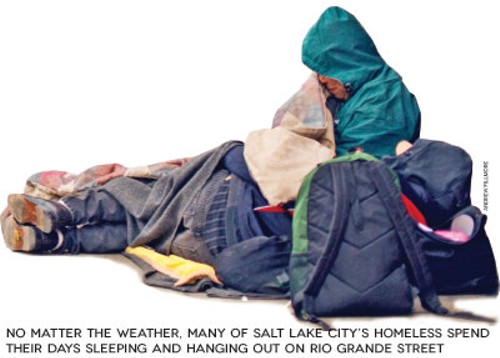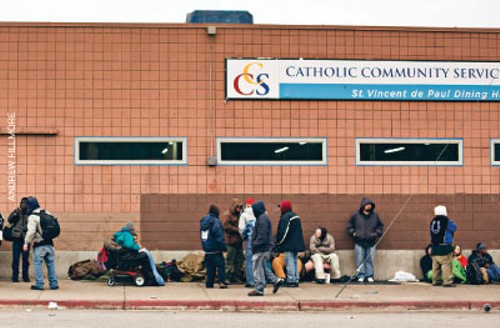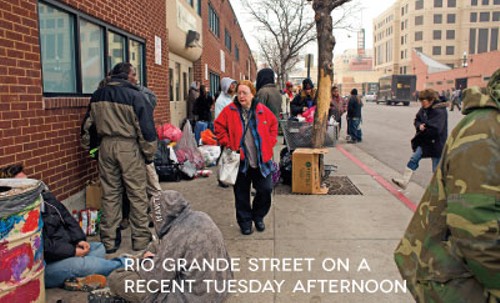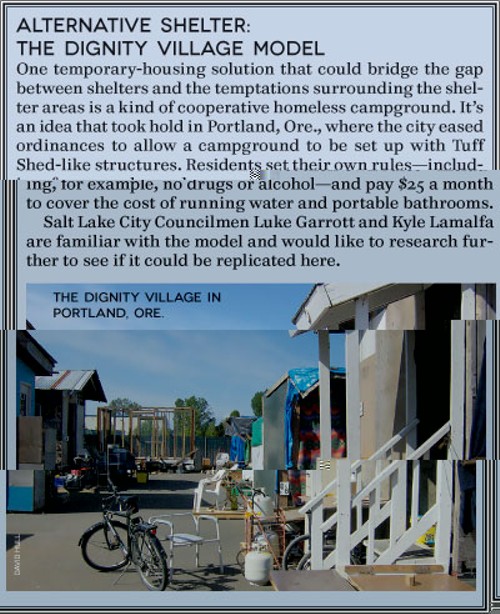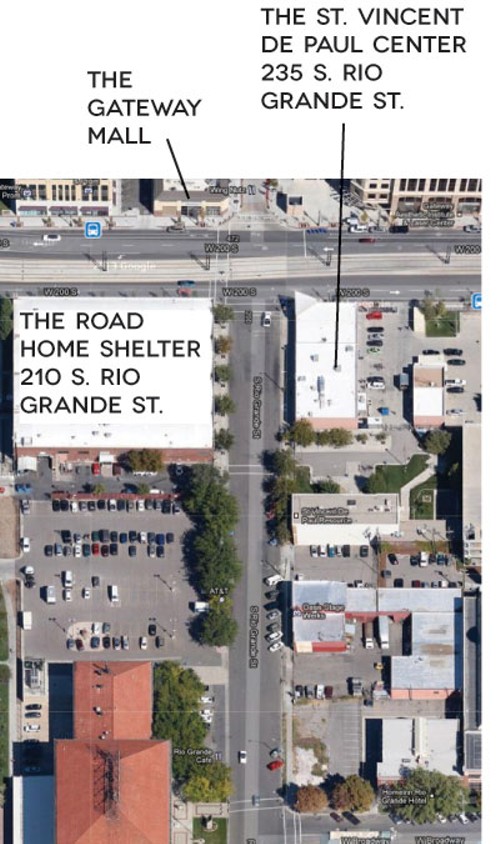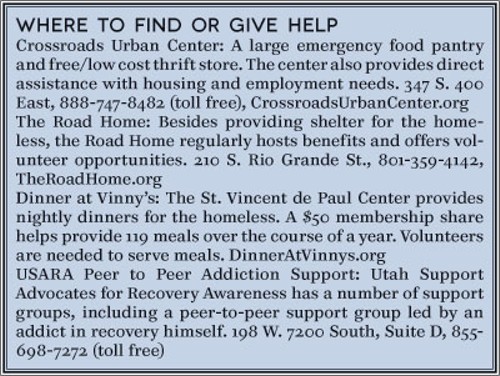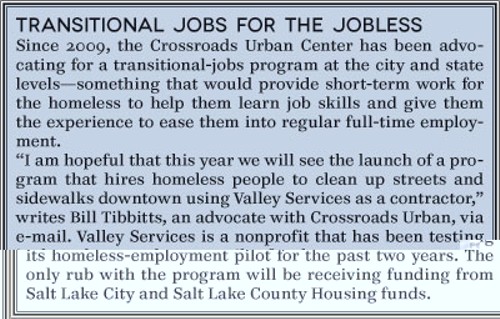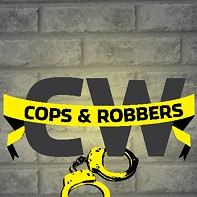I Know I'm Invisible
Ignoring SLC's homeless exacts hidden toll in human lives and taxpayer dollars.
By Eric S. Peterson @ericspetersonAt first glance, he just looked wasted. A man lay passed out on a curb, unconscious to the world, but with an unlit cigarette clenched between his teeth.
Then he stopped breathing.
A girl in a blue coat suddenly appeared over the man, begging with slurred words for him to wake up, hitting him in the heart with short, sharp punches, until at last he began to cough.
The woman chalked her trick up to things you learn from being on heroin. No sooner had a staffer from the Weigand Homeless Day Center called an ambulance to Rio Grande Street, in Salt Lake City’s Gateway neighborhood, than the woman disappeared.
The man’s breath, however, was slow and wheezing. Next to him, another man dropped quickly to his knees and folded his hands in front of his bowed head, reciting a quick and desperate prayer while a small crowd gathered, smoking cigarettes and watching. A man in a camouflage jacket strolled by without a second look, offering: “Just kick him in the ass, he’ll get up.” The man remained on the ground, eyes closed, a pained look twisting the features of his face. A slow stream of thick snot oozed from his mouth and nose, bubbling with every ragged breath.
As the paramedics cleared his breathing passage and loaded him onto a stretcher, an elderly black woman rolled into the courtyard, pushing a cart decorated with a bright-gold Christmas wreath.
“Another body taken by the plague!” she bellowed. “That’s what that is right here, a plague!”
Then the residents of Rio Grande Street shuffled past the scene, heading inside the St. Vincent de Paul Center for a lunch of hard bread, ground beef, sugar cookies and salad. Just another day and another routine ambulance call—one of 63 to that street in 2012.
The plight of Salt Lake City’s homeless is perhaps the most tragic news story that isn’t. It’s not news because the suffering and despair of those who have fallen through the cracks is anything but new. The homeless lack the money, health and opportunity for stable work to get them off the street, but they manage to scrape together enough money for the poisons that keep them there.
I spent hours on the street, ate meals at the St. Vincent de Paul Center and, while the weather was still warm, spent a night at the Road Home men’s shelter in close observation of this nexus of support, warm beds and meals—and cold streets and hard drugs.
In the politics of poverty, a typical soundbite refers to those who have “fallen between the cracks.” To stroll down Rio Grande Street is to see firsthand what life looks like between the cracks. People with drug problems, criminal records and mental illnesses clot the south side of 200 South, west of 400 West, just across the street from the cheery Gateway mall on the other side of 200 South.
My observations are also backed by disturbing statistics of police responses to this block, in a city of nearly 200,000. In 2012, this one block saw police respond to 82 calls for simple assault, 19 complaints of aggravated assault, 24 calls for dealing with mentally ill citizens, and eight suicide attempts. In 2012, Salt Lake City as a whole saw the deaths of 52 homeless individuals, whose years of substance abuse and inadequate care likely hastened their demise.
It’s a mini-community where the chronically homeless, the newly homeless and those just passing through take to the food lines and shelter dorms as if they were replicating the social cliques and rituals of high school—gossiping, laughing, and hanging out with friends. Some don’t have friends and talk only to their lapels and the people nobody else sees. Lapel talk ranges from the sad and quiet: “If anyone should be calling anyone names, it’s you”; to the quiet and disturbing non sequiturs: “shit-stained, pee-stained panties!”; to the loud and bizarrely political: “Condoleeza! Condoleeza fucking Rice!”
The 2013 Legislature will decide this session whether or not to expand Medicaid as part of President Obama’s Affordable Care Act, with federal money ready to usher in new homeless services and substance-abuse treatment. The conservative Legislature will likely defiantly decline the expansion as wasteful federal spending (See “Who Deserves Health Care?” Jan. 31, City Weekly). But if the state’s conservative lawmakers say no, what will Salt Lake City’s progressive city and county leadership do?
A few members of the Salt Lake City Council are eyeing possible reforms for low-income housing options. A spokeswoman for Democratic Salt Lake County Mayor Ben McAdams says his office will continue the same level of “facilitating” it always has between its existing homeless services committees and nonprofit networks.
Local government historically just passes federal block grants onto community nonprofits. Jesse Fruhwirth, a former City Weekly reporter and now a full-time activist, points out that while local governments may be stingy with city dollars to help treat and house the homeless, they have no trouble paying police to deal with the effects of homelessness.
“It’s weird that local government says they aren’t involved in these things, because they already are,” Fruhwirth says. “This police response is a response to unmet health-care needs in our community.” He adds that it is hard for the city’s progressive voters to fathom the degree of police enforcement, especially when “people like Ralph Becker are the face of it all.
“We are spending taxpayer money to address public-health needs with armed guards,” Fruhwirth says. “We’re already spending this money—what we need to talk about is how we choose to spend it.”
Gimme Shelter
“Jeff” is a 26-year-old alcoholic who originally landed in Utah after being cycled through jails and shelters in Alamo, Nev, and Reno, Nev. Jeff [not his real name] says he stayed briefly with his mother and her boyfriend until his drinking wore on their nerves. His mother’s boyfriend pulled him out of his bed while he was drunk and took him to the hospital. Jeff’s recollections of the visit are mostly a blur, except of waking up at the hospital with an IV in his arm. He promptly pulled it out and, with blood trailing, made for the exit, when a police officer quickly arrested him for public intoxication, at a hospital, in the middle of the night.
“Yeah, they laughed when I told ’em that in jail, too,” Jeff says with a wry grin. I met Jeff the first day he got out of jail in December. With a cherubic smile, thin goatee and dark sunglasses, Jeff has something of a resemblance to the actor Zach Galifianakis. When we first met, he could laugh at his new street-side status. A month later, when I would meet him again, his health, hope and optimism was ragged and ground flatter than a stomped-down cigarette butt.
“I couldn’t understand why people would sleep out on the street when I first got here,” Jeff says. “Then I found out the shelter smells like ass.”
The Road Home Shelter at 210 S. Rio Grande St. provides shelter to hundreds of individuals and families every day of the year and also opens an emergency overflow shelter, with a 300-bed capacity, during the winter months. It is refuge from the elements and an essential life-saver but, unsurprisingly, it’s not an easy night’s sleep. I took an opportunity in early December to spend the night before the winter cold took hold.
The inside of the shelter was essentially a barrack filled with gray bunk beds, each furnished with a thin, plastic-encased mattress. A small lounge area includes a TV and snack vending machines. There are bathrooms and showers; as a safety precaution, though, the bathrooms have no doors on the stalls.
It was possibly the worst night of sleep of my life. As a result of having 200-plus men in an open area, there is not a moment in the night not punctuated by a cough, sneeze, fart or sudden outburst of profanity. In the middle of the night, one elderly man was 20 feet shy of a garbage can when he sprayed vomit next to my bunk. A staffer helped the man out and cleaned up the mess. At 5:30 a.m., the lights came on, and it was time to leave and face the day.
“Handle Your Shit”
In 2012, the little pocket of desperation on Rio Grande Street saw 82 police responses to complaints of “simple assault,” which can range from shoves to brawls. That year, police made eight arrests from the 82 complaints and six aggravated assault arrests from 19 complaints (see map, p. 18). With Rio Grande occupied by so many cop-wary inhabitants, enforcement for most any crime is a challenge, which means residents tend to settle their differences on their own.
In mid-January, two men charged full speed toward each other from either side of Rio Grande, colliding in the middle of the road, swinging wild punches over each other’s heads, while an onlooker yelled, “Handle your shit!” By the time I had my phone out to call the police, the fight ended after one of the brawlers landed a knee on the other’s ribs with a thud, while friends intervened to break up the fight.
Salt Lake City Police Sgt. Jenn Diederich, who has policed the shelter area since 2011, says it’s no coincidence that when patrol cars approach the street, people start whistling.
“It’s one of those areas well sought-after for drugs,” Diederich says. “It’s hard to curb, but we do a bit.”
Observation of drug selling and using on Rio Grande, however, suggests a largely unchecked open-air drug market. Police records show little luck in making drug arrests on Rio Grande. In 2012, for example, this street saw just two arrests for drug sales, both for cocaine. The area did see 37 drug-possession arrests, but 20 of those arrests were for possession of narcotic paraphernalia. To put this in perspective, I witnessed more drug sales on my first night hanging out on Rio Grande than there were drug-sale arrests made on the street for all of 2012.
Diederich takes pride in SLCPD’s Homeless Outreach Services Team (HOST), which, since 2011, has worked collaboratively with service providers to try to improve relationships with homeless residents and refer them to services instead of just giving them tickets. Diederich says her squad has helped 10 individuals find more stable housing since the program launched.
She believes her squad has learned how to keep better relations with the homeless by prioritizing the prevention of serious violence over petty offenses.
“Sometimes, you give up the little things to get the big things,” Diederich says.
But it seems of the variety of officers who patrol the area, some still apparently do worry about the little things.
At Judge John Baxter’s “Homeless Court”—a justice court held twice a month in the Weigand Day Center that helps refer homeless people to community service as opposed to jail—the judge shakes his head upon seeing yet another ticket for spitting on the street issued by the same officer.
“Well, I have this cough, so I spit,” says a woman in her 60s.
“Well, ’tis the season,” Baxter says, giving her two hours of community service.
Baxter says that if more of these “nuisance” charges were fought, it could deter the writing of frivolous tickets. But most homeless people won’t invest the time to defend themselves. The homeless “simply don’t take them to trial,” Baxter says.
Salt Lake City Police Chief Chris Burbank is proud of HOST, but he’s also realistic about “the business we’re in,” as he puts it. Police have to respond to complaints.
“If a drug dealer goes up into the Avenues and stands on a corner, I’m going to get 25 phone calls,” Burbank says. “Down in that area, we don’t get the phone calls.”
Burbank says dealers exploit the homeless with drugs or threats of violence, and the homeless don’t reach out to police because of mistrust. He hopes the department’s softer approach can build better relationships with residents in the area. But that desire can be thwarted, however, in the way police respond to complaints of the homeless “trespassing” on the property of a restaurant located at 270 Rio Grande St.
In fall 2012, Mark Stewart, who is not homeless, was working as a server at a restaurant in The Gateway. He walked through the parking lot and received a trespassing ticket.
Stewart says he was taken aback by the fact that police seemed to be waiting for him there. He recently requested trespassing records from the Salt Lake City Police Department for the parking lot and shared the information with City Weekly.
According to the records, SLCPD responded to three trespassing incidences in 2010, nine in 2011 and a whopping 189 in 2012.
“Police are handing out no trespassing tickets like candy [to the homeless],” Stewart says.
Sgt. Michelle Ross, head of the SLCPD’s HOST team, says that officers in the shelter area walk a difficult line between building trust and maintaining a police presence to ward off the hard-core criminals who hide among the homeless.
“You can’t just disappear because then the criminals end up running the street,” Ross says. She also says that not every police officer is a HOST officer who’s had the sensitivity training needed to refer the homeless to help instead of just citing or arresting them. Within the next few months, however, Ross hopes to expand the training to all officers.
“What we’re trying to do is roll out the HOST program citywide,” Ross says.
Socialized Medicine
In observing police on Rio Grande, I did notice officers routinely working to see that people were OK, rather than to see if they were breaking the law. Officers often stopped to make sure the people lying on the sidewalks wrapped in frost-covered blankets were healthy and well.
Salt Lake City Fire Department Captain Chris Valdez describes the area as the closest things Utah’s got to “socialized medicine.” He estimates half his calls from Fire Station No. 2 go to the shelter area, responding to heart attacks, seizures, drug overdoses and, frequently, individuals who are gaming the system just to spend the night in the hospital.
“It’s not a really healthy population, and the 911 system has become, in some ways, the primary medical care for them,” Valdez says. He estimates that every visit to the street likely costs $100 to $200 for the taxpayers. When individuals have to go to the hospital, it can bill Medicaid as much as $1,500.
No Country for Old Junkies
The Rio Grande homeless community often exists by its own rules. When mental illness, criminal records and an adapted mistrust of authority seem to leave some without help, they find ways to help themselves.
This kind of adaption is simply “survival” if you were to ask “Hank,” who, at age 52, is an “old school” soul of the street. Unlike Jeff, who has spent less than a decade on the street, Hank has chosen the street life for the past 35 years, ever since he got out of prison in Illinois in the ’80s. It was his first stint inside after having wrecked a car with a trunk full of guns and dope. Surviving brutal prison life left him with the impression that his brand of survival is what he’s best at, even if it means he spends his life on the streets.
Hank is thin, yet muscular, with tattoos that cover the lengths of his arms, and a copper-tinged goatee that surrounds a wild smile. As far as survival by criminal means, he’s “been there, done that and got a T-shirt.” This includes serving time in Nebraska for armed robbery and in California for manslaughter after he unloaded a clip into a man looking to rob him of 2 pounds of speed. Nowadays, his crimes are mostly petty, since he’s been looking for a job as a maintenance technician.
Once, while I was speaking with Hank on Rio Grande, a police car rolled up in front of us so an officer could help an elderly man make it into the shelter. As this happened, Hank casually stuffed a small bag of pills into his cheek and continued talking.
Hank believes in the street, but he also recognizes that it’s a place where people can either kill themselves in whatever way they choose or get care if they want—and most choose not to.
“People out there say, ‘Oh, I can’t get help,’ ” Hank says. “Fuck you, you can get help, but you don’t want it—and that applies to every swinging dick up and down this street.”
He is philosophical about the war on drugs, arguing that when drugs and users are the targets of police prosecution, it creates environments like Rio Grande, where desperate people who mistrust the police engage in violence.
But on the other hand, he argues, “the street takes care of people.” That evening, a man borrowed Hank’s lighter and gave him a pack of gum as thanks. Up the block, when an elderly woman fell on the ice, Hank and I helped walk her to the women’s shelter entrance. The street culture seems to operate on favors, alliances and support from people who don’t judge one another for being addicts because they are addicts themselves.
Hank acknowledges that people can be lost to the streets, he himself having lost a friend two nights prior to my first meeting with him. His friend drank a bottle of mouthwash, passed out on the street and never woke up.
“There are no old junkies,” Hank says.
Progressively Apathetic
Salt Lake City Council Chair Kyle Lamalfa is open to partnering with other entities to do more homeless services outreach, but also says that the city shouldn’t fully fund or run major programs. Doing so would cut into other benefits—park grass would go unwatered or parking rates would have to be increased.
“I know voters in Salt Lake City are progressive, but when it comes to making those hard choices, it really hits home,” Lamalfa says.
Salt Lake City Councilman Luke Garrott, whose 4th District includes downtown Salt Lake City, says that ever since the Reagan administration cut federal dollars that cities used to provide homeless services in the ’80s, Salt Lake City, like other cities, hasn’t funded social-justice programs (now, most of the help comes through nonprofits that administer federal grants). While cities receive less, he doesn’t see it as an excuse not to try.
“Cities have abrogated a lot of their social-justice responsibilities, given the Reagan-era cuts, and Clinton administration cuts, for that matter,” Garrott says. “But we can’t ignore vital parts of our community, and the poor and vulnerable are parts of our community. We can’t and shouldn’t just shove off responsibility on to other levels of government.”
Salt Lake City Mayor Ralph Becker’s spokesman, Art Raymond, points out that the city keeps busy just coordinating federal grants with the right service providers. While he acknowledges there’s not much political will for direct funding, he does point out that Becker is looking to forge regional partnerships to pool resources on the homeless issue.
“The homeless issue isn’t a Salt Lake City thing, it’s a societal thing,” Raymond says. “But it’s also something we’re hoping to encourage our nearby valley municipalities to be involved with fiscally, and see what we can do at that level.”
Slow-Motion Suicide
The poet E.E. Cummings penned a line describing the world of an eccentric New York City bowery bum, describing an “amoral morality sort-of-aliveing by innumerable kind-of-deaths.”
When I met Jeff at the Salt Lake City Main Library a month after seeing him last, he was in a “sort-of-aliveing” kind of state. After suffering for five weeks with flu, pink eye and a case of strep throat that gave him a rattling cough, he bought a box of soda and sold the cans individually for a profit that he used to buy a pint of vodka. Call it a justification or an excuse, Jeff says he hoped the alcohol might kill the infection in his throat. Still, he seemed ashamed that I had caught up with him after he’d fallen off the wagon for the first time in months.
Jeff’s days, he says, are spent in the library filling out job applications, most for temporary staffing positions that have gone nowhere. Worn down, he says he’s committed to getting out of his situation, but he’s losing heart. Jeff does not aspire to survive the same way Hank does. For him, getting sober, getting a place to live, getting a job and going to school is just “existing.” Where he’s at now, he doesn’t consider living.
“I’ve lived once, it was nice,” Jeff says.
More by Eric S. Peterson
-
The Secret Sauce
How Utah lawmakers disclose—or don't disclose—conflicts of interest.
- Feb 14, 2024
-
Police departments in Salt Lake County spent almost $20 million on civil rights complaints in the past decade
The Co$t of Mi$conduct
- Oct 18, 2023
-
Women decry harassment and toxic culture at St. George auto dealership
Men at Work
- Oct 11, 2023
- More »
Latest in Cover Story
Readers also liked…
-
Forget the family pedigree—Robert F. Kennedy Jr should not be the next president of the United States
Trojan Horse
- Jun 21, 2023
-
Women decry harassment and toxic culture at St. George auto dealership
Men at Work
- Oct 11, 2023



